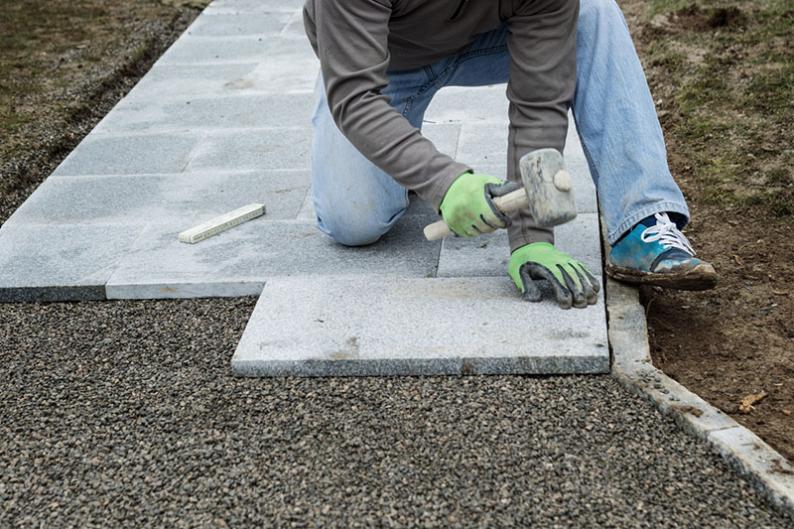
Whether you plan to work with a specialized landscape contractor or tackle a project yourself, it is important to know how you or your contractor will prepare your base for the type of project you are undertaking.
The most important part of the project is the preparation of the correct base for the type of soil that you are working with. This for all intents and purposes is the patio, walkway or driveway and the patio stones or interlocking pavers are the “icing on the cake” which will stay beautiful and enjoyable for years to come if everything underground has been prepared correctly.
The following is a simplified perspective on building a patio, walkway or driveway. For full details, it is always recommended to consult with your contractor or industry experts, especially when identifying what type of soil your project is being built on.
- Planning – Draw a plan view showing measurements and grade elevations – remember, “a picture says a 1,000 words.” This will assist with explaining your intended project to your potential landscape contractors when you are sourcing quotes or when working with your local experts who will help to assist you with calculations for base materials and patio stones (styles, colours, type) required for your project.
- Preparation - Mark out the location of the patio, walkway or driveway. Call the utilities (i.e. gas, electricity), phone company and cable T.V. for locates. Tools Required: Wheelbarrow, rake, shovel, plate compactor (with protector), guillotine and/or masonry saw, tape measure, gloves, safety glasses, ear protection. In some cases, heavy earth moving equipment may be required depending on the scope of the project and the materials being worked with.
- Excavation – Excavate the minimum required depth depending on your application (your local experts or contractor can make recommendations for this based specific questions regarding your soil content and by referring to a Base Thickness Chart). For walkways, excavate a minimum of 3” wider than the area. For driveways and patios excavate a minimum of 6” wider than the area you are applying pavers to.
- Base – Fill the area with gravel (Granular A) – depth based on recommendations from the Base Thickness Chart – available at your local experts. Grade the base as closely as possible to the final contour of the finished job. Slope all installations away from the house or building for drainage purposes. (Minimum 1/8” slope over every 10 feet) The gravel should be 3” below finished height. Compact maximum 3” thick at a time.
- Screeding – Pavers are laid on a 1” bed of coarse sand, and placed directly on the compacted base. Use a 1” diameter pipe as a screeding guide on top of the gravel. Set up the guides so that your pavers are 3/8” above the finished level to allow for compacting. Level the sand evenly by pulling a board along the pipes. Once you have completed the area, remove the guides, and fill in the grooves. Do not walk on the screeded surface.
- Laying the Pavers – Place the pavers directly on the screeded bed of sand. Start laying along the longest straight side. Keep lines straight using string lines. This will minimize the cutting required. It is important that the lines of your pavers are square, 90 degrees to each other, to fit properly. If you are installing circles, fans or a soldier course (a border of pavers around the area), you will want to place these first before installing the rest of the pattern.
- Cutting – You may need to cut pavers that don’t fit along edges or around objects. Mark the pavers and cut with either a guillotine cutter or masonry saw. A guillotine cutter is the easiest method of cutting, but for an exact cut, a “dry cut” masonry saw or a tub-style “wet saw” works best. These can be rented at your local rental outlet. Always wear appropriate safety gear when cutting.
- Edging – Edge restraints are a critical element to the durability of a paver installation. They prevent the pavers from lateral movement and shifting over time. A product such as Snapedge is economical and effective. Various concrete products can be used as curbing also. Ask your local experts for details.
- Compacting – After the installation is complete, including edge restraints, the pavers must be swept clean and then compacted with a plate compactor (and protector). This helps settle the pavers into the bedding sand and creates a flat surface. (For patterns, such as circles, you may want to put some jointing sand in first to stabilize the smaller pieces.) We recommend a minimum of three passes with the compactor going in different directions.
- Finishing – Sweep Jointing Sand into the joints between the pavers. This locks the pavers together, creating a very durable surface. For additional protection from the penetration of weeds and insects, use Polymeric Sand in various matching colours to create a sealed joint, which will also resist erosion in sloped applications.
